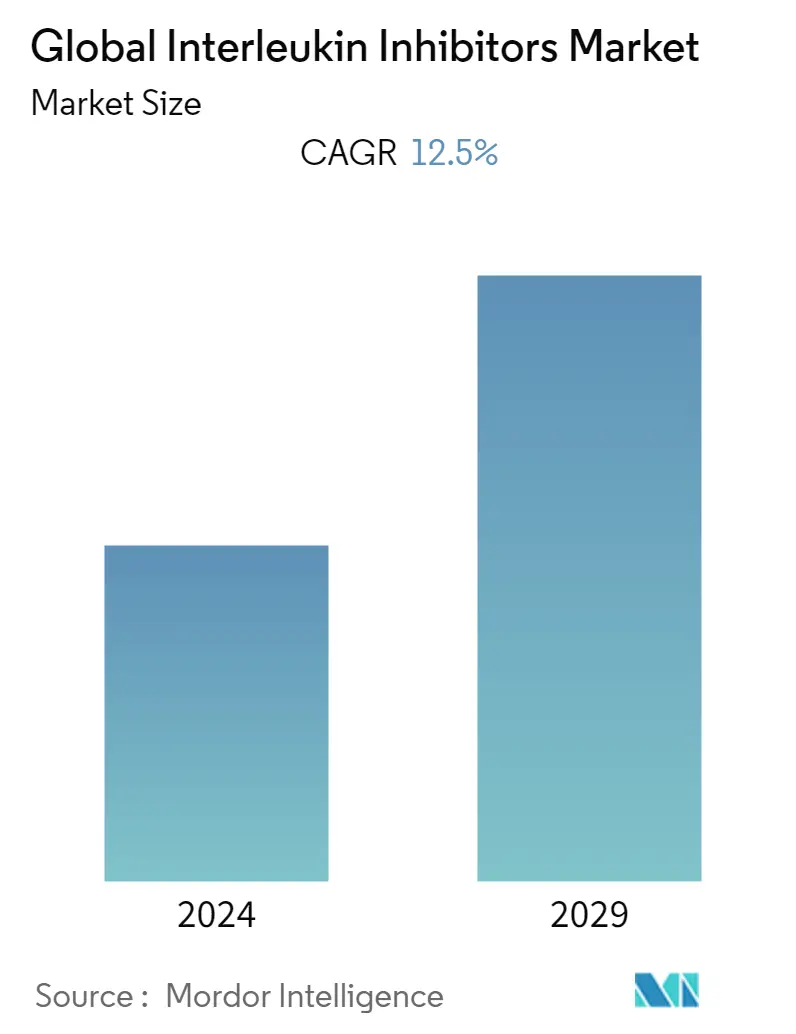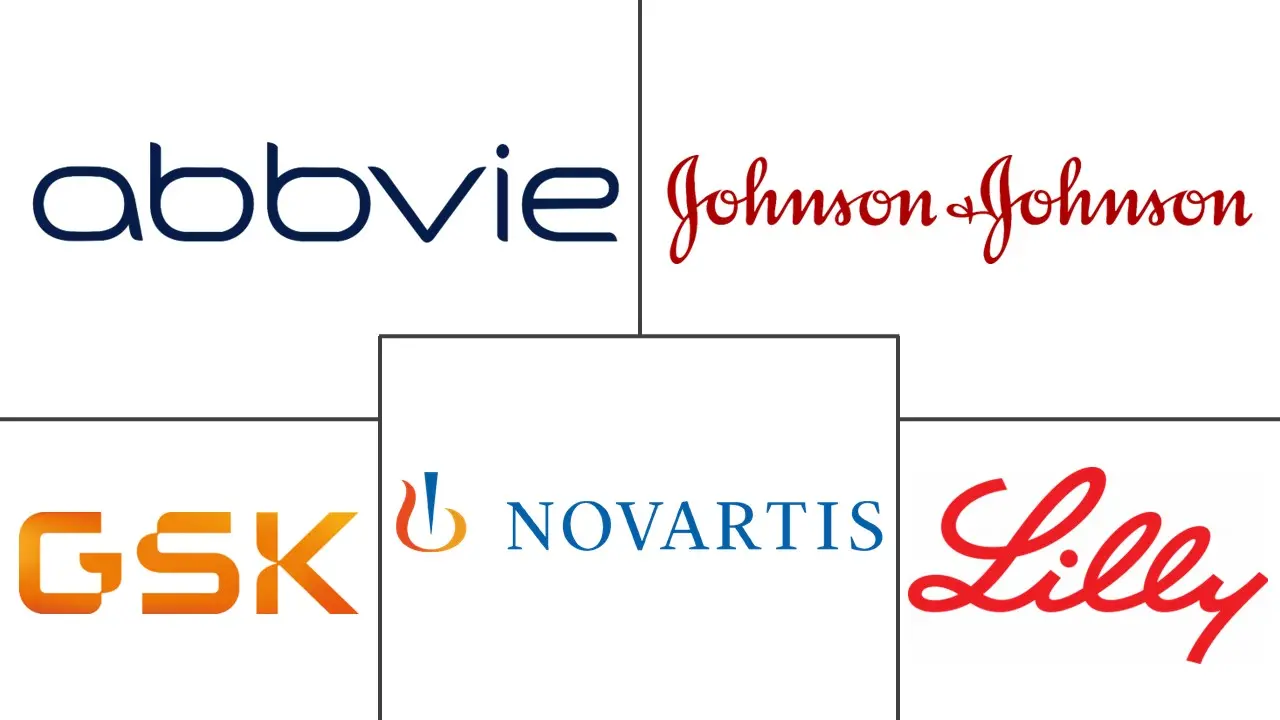Market Size of Global Interleukin Inhibitors Industry

| Study Period | 2019 - 2029 |
| Base Year For Estimation | 2023 |
| CAGR | 12.50 % |
| Fastest Growing Market | North America |
| Largest Market | Asia Pacific |
| Market Concentration | Medium |
Major Players
*Disclaimer: Major Players sorted in no particular order |
Interleukin Inhibitors Market Analysis
The Interleukin Inhibitors Market is expected to register a CAGR of 12.5% during the forecast period.
The pandemic had an adverse effect on the studied market. However, the drug has the potential to provide therapeutic support in Covid treatment. According to a research study published in August 2020 with the title "The role of Interleukin 6 inhibitors in therapy of severe COVID-19," cytokine storm syndrome (CSS) is a serious complication of treating malignancies or inflammatory immune diseases, and it can also manifest during the progression of COVID-19. The pathophysiology of CSS is significantly influenced by interleukin-6 (IL-6). Numerous investigations that demonstrated that patients with severe COVID-19 had higher plasma concentrations of IL-6 corroborated the important role that IL-6 plays in the pathophysiology of the disease. Studies that sought to identify additional pertinent therapeutic targets for the treatment of CSS in patients with COVID-19 are necessary for the creation of customized immunomodulatory therapy, given the role of cytokines in pathogenesis. Thus, the market is expected to grow in the future.
The major factors driving the growth of the market include the increasing global prevalence of autoimmune disorders and rising geriatric population and technological advancements in the development of novel interleukin inhibitors. According to the Yondala Smith article titled 'Psoriasis Epidemiology' updated in March 2021, Psoriasis affects approximately 125 million people globally, which is about 2.2% of the worldwide population. The prevalence varies in different areas of the world. However, higher rates are reported in developed countries accounting for 4.6% of the population. The same source also reported that the incidence of psoriasis is most common between the ages of 15 and 25, however, it may affect individuals of any age. Psoriatic arthritis typically develops ten years or more after the initial diagnosis of psoriasis, between the ages of 30 and 50. Such a high burden of diseases is boosting the growth of the market. Furthermore, an article in the Journal of the European Academy of Dermatology and Venerology titled 'Prevalence of Most Common Skin Diseases in Europe: A Population-based Study,' published in March 2022, reported that in France, the prevalence of psoriasis is 3.92%, which accounts for more than 16 million people. Also, as per the 2021 International Foundation For Gastrointestinal Disorders (IFFGD), 10 to 15% of the population is affected by irritable bowel syndrome worldwide, including 25 to 45 million people afflicted with the disease in the United States. As Crohn's disease is a type of irritable bowel syndrome, its increasing burden also boosts the growth of the market. Additionally, according to the October 2021 update of the World Health Organization, the percentage of people aged more than 60 years in the global population is expected to increase from 12% in 2015 to 22% by 2050, of which about 80% of the older people in 2050 are anticipated to be living in the low-and middle-income countries. Such an increasing burden on the geriatric population is expected to boost the growth of the market over the forecast period. Product launches are another factor in market growth. For instance, in July 2020, UCB announced positive results from the Phase 3b BE RADIANT study for the use of the IL-17A and IL-17F inhibitor bimekizumab in the treatment of adult patients with moderate-to-severe plaque psoriasis. Similarly, in March 2020, Sanofi and Regeneron launched trials for evaluating the efficacy of Kevzara which is an interleukin-6 inhibitor (IL-6) for the treatment of severely ill COVID-19 patients.Thus, owing to the above-mentioned factors it is expected to drive market growth over the forecast period.
However, the high cost of the treatment and stringent regulatory policies are expected to hinder market growth.
Interleukin Inhibitors Industry Segmentation
As per the scope of the report, Interleukin inhibitors are immunosuppressive agents which inhibit the action of interleukins which are synthesized by monocytes, macrophages, lymphocytes and certain other cells. The Interleukin Inhibitors Market is Segmented by Type (IL-1, IL-5, IL-6, IL-17, IL-23, and Other Types), Application (Psoriasis, Arthritis, Asthma, Inflammatory Bowel Disease, and Other Applications), and Geography (North America, Europe, Asia-Pacific, Middle East and Africa, and South America). The market report also covers the estimated market sizes and trends for 17 different countries across major regions, globally. The report offers the value (in USD million) for the above segments.
| By Type | |
| IL-1 | |
| IL-5 | |
| IL-6 | |
| IL-17 | |
| IL-23 | |
| Other types |
| By Application | |
| Psoriasis | |
| Arthritis | |
| Asthma | |
| Inflammatory Bowel Disease (IBD) | |
| Other Applications |
| Geography | ||||||||
| ||||||||
| ||||||||
| ||||||||
| ||||||||
|
Global Interleukin Inhibitors Market Size Summary
The Interleukin Inhibitors Market is poised for significant growth, driven by the increasing prevalence of autoimmune disorders and a rising geriatric population. Technological advancements in the development of novel interleukin inhibitors further bolster this growth trajectory. The market's expansion is also supported by the therapeutic potential of these inhibitors in treating conditions like COVID-19, where interleukin-6 plays a crucial role in the disease's pathophysiology. The high burden of diseases such as psoriasis and Crohn's disease, along with the growing aging population, particularly in low-and middle-income countries, is expected to propel market growth. Product launches and clinical trials, such as those by UCB and Sanofi, highlight the ongoing innovation and investment in this sector, contributing to the market's positive outlook.
However, the market faces challenges, including the high cost of treatment and stringent regulatory policies, which may hinder its growth. The United States is anticipated to hold a significant market share due to its robust healthcare infrastructure, proactive government initiatives, and substantial healthcare expenditure. The presence of major market players like AbbVie, Johnson and Johnson, and Novartis AG, along with strategic partnerships and regional expansions, are key factors influencing market dynamics. Despite these challenges, the market's potential for growth remains strong, driven by the increasing demand for effective treatments and the ongoing development of interleukin inhibitors.
Global Interleukin Inhibitors Market Size - Table of Contents
-
1. MARKET DYNAMICS
-
1.1 Market Overview
-
1.2 Market Drivers
-
1.2.1 Increasing Global Prevalence of Autoimmune Disorders and Rising Geriatric Popuation
-
1.2.2 Technological Advancements
-
-
1.3 Market Restraints
-
1.3.1 High Cost of the Treatment
-
1.3.2 Stringent Regulatory Policies
-
-
1.4 Porter's Five Force Analysis
-
1.4.1 Threat of New Entrants
-
1.4.2 Bargaining Power of Buyers/Consumers
-
1.4.3 Bargaining Power of Suppliers
-
1.4.4 Threat of Substitute Products
-
1.4.5 Intensity of Competitive Rivalry
-
-
-
2. MARKET SEGMENTATION (Market Size by Value - USD million)
-
2.1 By Type
-
2.1.1 IL-1
-
2.1.2 IL-5
-
2.1.3 IL-6
-
2.1.4 IL-17
-
2.1.5 IL-23
-
2.1.6 Other types
-
-
2.2 By Application
-
2.2.1 Psoriasis
-
2.2.2 Arthritis
-
2.2.3 Asthma
-
2.2.4 Inflammatory Bowel Disease (IBD)
-
2.2.5 Other Applications
-
-
2.3 Geography
-
2.3.1 North America
-
2.3.1.1 United States
-
2.3.1.2 Canada
-
2.3.1.3 Mexico
-
-
2.3.2 Europe
-
2.3.2.1 Germany
-
2.3.2.2 United Kingdom
-
2.3.2.3 France
-
2.3.2.4 Italy
-
2.3.2.5 Spain
-
2.3.2.6 Rest of Europe
-
-
2.3.3 Asia-Pacific
-
2.3.3.1 China
-
2.3.3.2 Japan
-
2.3.3.3 India
-
2.3.3.4 Australia
-
2.3.3.5 South Korea
-
2.3.3.6 Rest of Asia-Pacific
-
-
2.3.4 Middle-East and Africa
-
2.3.4.1 GCC
-
2.3.4.2 South Africa
-
2.3.4.3 Rest of Middle East and Africa
-
-
2.3.5 South America
-
2.3.5.1 Brazil
-
2.3.5.2 Argentina
-
2.3.5.3 Rest of South America
-
-
-
Global Interleukin Inhibitors Market Size FAQs
What is the current Global Interleukin Inhibitors Market size?
The Global Interleukin Inhibitors Market is projected to register a CAGR of 12.5% during the forecast period (2024-2029)
Who are the key players in Global Interleukin Inhibitors Market?
AbbVie, Inc, Johnson and Johnson, Novartis AG, Eli Lilly and Company and GlaxoSmithKline Plc are the major companies operating in the Global Interleukin Inhibitors Market.

